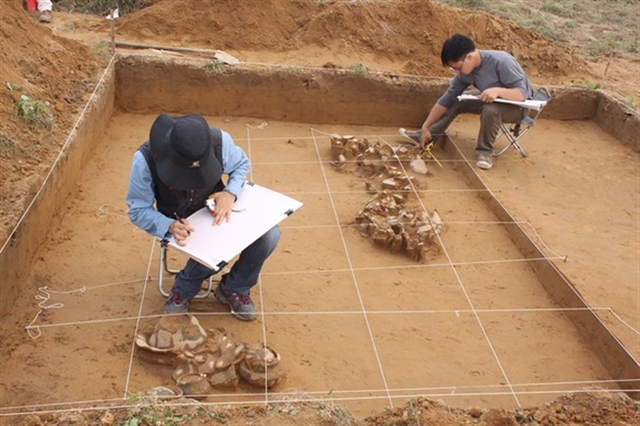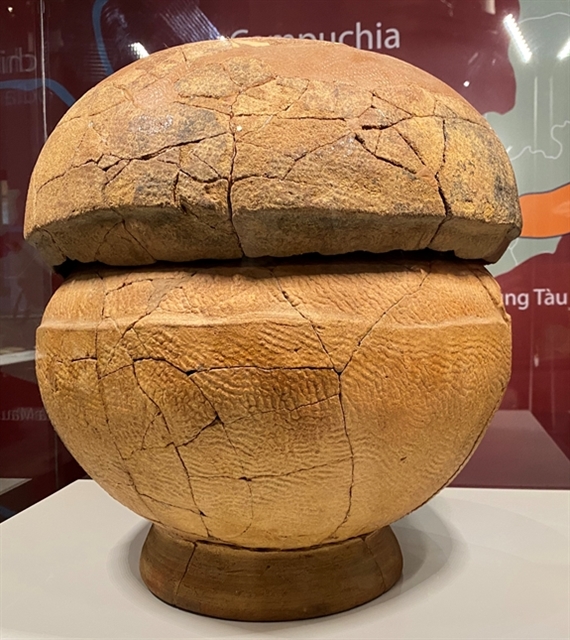HÀ NỘI A unique exhibition in downtown Hà Nội is featuring Bãi Cọi in the central province of Hà Tĩnh, a special archaeological site bearing the characteristics of the Đông Sơn (800-200BC) and Sa Huỳnh (1,000-200BC) civilisations.
The site includes Bãi Cọi and several places surrounding it like Bãi Lòi and Bãi Phôi Phối in Xuân Viên Commune, Nghi Xuân District of Hà Tĩnh Province.
The area is located at the foot of Hồng Lĩnh Mountain, by the La River, the natural border of Nghệ An and Hà Tĩnh provinces.

Archaeologists work at the site. Photos courtesy of the organisers
After many excavations conducted by Vietnamese and South Korean archaeologists, the site has been proven to have features of both Đông Sơn and Sa Huỳnh civilisations.
The site was recognised as a National Level Relic Site in 2014 by the Ministry of Culture, Sports and Tourism.
The exhibition displays more than 15 objects and documents in various materials like stone, ceramic, metal and glass.
A tomb has been made at the exhibition to help the audience imagine the site in early history.
According to Nguyễn Văn Đoàn, director of the National Museum of Vietnamese History, the Đông Sơn civilisation was located from Hà Tĩnh-Quảng Bình to the north while the Sa Huỳnh civilisation stretched from Quảng Ngãi southward.
Discoveries at Bãi Cọi proved Hà Tĩnh is the meeting place of the two civilisations, he said.
“Findings at the site changed previous assumptions on the two civilisations,” he added. “Bãi Cọi has an important meaning in doing research on Việt Nam’s early history.”
In 1974, scientists from the Việt Nam Archaeology Institute unearthed many stone and bronze objects here. They assumed the site hosted many objects in a large area, which might have been a tomb area of Đông Sơn culture.
The museum and Hà Tĩnh’s culture department conducted excavations at the site in 2008 and 2009.
The first time, scientists gathered a large number of objects together with 16 tombs, which had features of Sa Huỳnh civilisation but influenced by Đông Sơn civilization of around 1st-2nd century AD.
At the end of 2009, another excavation was conducted at the site on further areas at Bãi Phôi Phối, Bãi Lòi, Tráng Vạn, and Phúc Đa Temple, which unearthed 13 ancient tombs and buried objects.

A ceramic jar tomb displayed at the exhibition. VNS Photo Đoàn Tùng
The findings showed the tomb site was spread in a large area, which existed from some 300AD to the 1st century AD.
In 2012, the site was excavated once more by the museum and the National Museum of Korean History, which unveiled 15 more tombs and many buried objects.
All the objects were then transferred to South Korea for research and restoration, including metal objects like earrings, bracelets, axes, knives and hoes.
South Korean archaeologists discovered various kinds of fibres stuck on the surface of the metal objects, which led them to do further research on the weaving of early people, said Nguyễn Mạnh Thắng, head of Research and Collecting Department of the museum.
“Modern facilities and careful research process helped us define materials and forms of objects found, which is a significant feature in the co-operation between the two museums,” he said.
Bãi Cọi is a complex of tombs scattered in a large area with two forms of tombs, namely bodies buried in soil and bodies buried in ceramic jars.
Thắng said ceramic jars in Bãi Cọi are of smaller size than those in Sa Huỳnh, Quảng Ngãi.
Soil tombs here have a later date compared jar ones. Scientist found here many soil tombs cut across jar tombs, which had been buried before.
The exhibition will run at the National Museum of Vietnamese History, No 1 Phạm Ngũ Lão Street, Hoàn Kiếm District, Hà Nội till the end of April next year. VNS

A model of twin tombs displayed at the exhibition. VNS Photo Đoàn Tùng
OVietnam